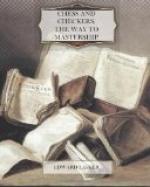Problems in which no definite number of moves are stipulated for the mate are usually called studies or endings. They are nothing but game positions in which a maneuver forces the win that is so well hidden that it would probably not be found by a player in an actual game. The following two positions are examples of this class of compositions.
The first move is evident. White must play (1) P-c7, as otherwise Black retreats with the Rook in the d-file and occupies the c-file so that he can be sacrificed at any time for White’s dangerous Pawn.
+---------------------------------------+ 8 | | | | | | | | | |---------------------------------------| 7 | | | | | | | | | |---------------------------------------| 6 | | ^K | ^P | | | | | | |---------------------------------------| 5 | | | | #R | | | | | |---------------------------------------| 4 | | | | | | | | | |---------------------------------------| 3 | | | | | | | | | |---------------------------------------| 2 | | | | | | | | | |---------------------------------------| 1 | #K | | | | | | | | +---------------------------------------+ a b c d e f g h
Diagram 82.—White to play and win.
After (1) ..., R-d6+ White can neither go to b7 on account of R-d7 nor can he play K-c6 or c5 on account of R-d1 followed by R-c1 whereby Black would draw. The only way to win is: (2) K-b5, R-d5+; (3) K-b4, R-d4+; (4) K-b3, R-d3+; (5) K-c2. At last White has succeeded in guarding his rear, and it seems as if Black could not any longer prevent the Pawn from Queening. However, Black plays (5) ..., R-d4 and if White queens the Pawn he gives check on C4 forcing Qxc4 which would stalemate the King.
+---------------------------------------+ 8 | | | | | | | ^K | | |---------------------------------------| 7 | | | | | | | ^P | | |---------------------------------------| 6 | | | #B | ^B | | | | | |---------------------------------------| 5 | | | | | | | | | |---------------------------------------| 4 | | | | | | | | | |---------------------------------------| 3 | | | | | | | | | |---------------------------------------| 2 | | | ^Kt| | | #P | | #P | |---------------------------------------| 1 | | | | #K | | | | | +---------------------------------------+ a b c d e f g h
Diagram 83.—White to Move and Draw.
This is the point where the problem-trick enters the game. White does not promote the Pawn to a Queen but to a Rook, avoiding the stalemate and threatening mate on a8. Black’s only defense is R-a4 and now White wins by (7) K-b3 attacking the Rook and threatening mate on c1 at the same time.




